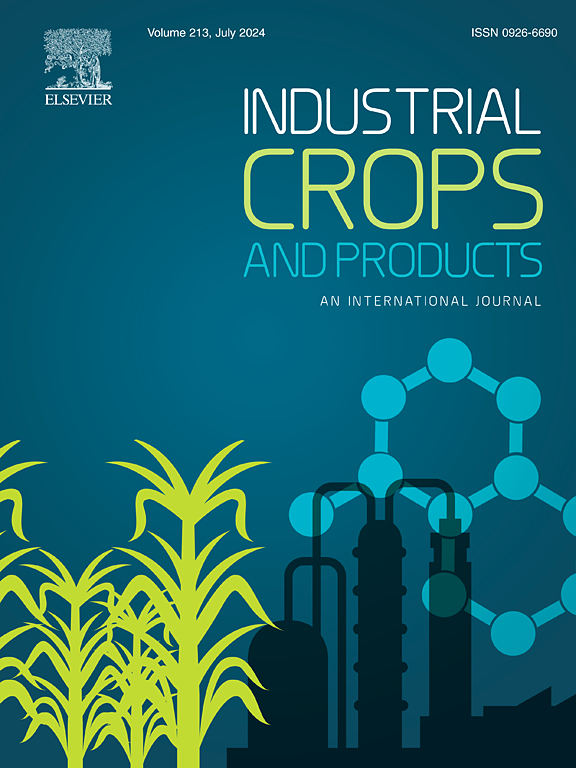间作系统的节水策略:水分调节和种植模式对根冠协调和农业水分生产力的综合效应
IF 5.6
1区 农林科学
Q1 AGRICULTURAL ENGINEERING
引用次数: 0
摘要
水资源短缺和土壤退化是干旱和半干旱地区农业生产面临的重大挑战。枸杞是干旱区重要的经济作物,对当地特色农业有重要贡献。改善其生长环境和优化水资源利用对农业资源的可持续利用和推进现代农林生产系统至关重要。通过为期3年的田间试验,研究了水分调节和种植方式对枸杞-紫花苜蓿系统的影响。四种灌溉方式(完全灌溉,W0;轻度亏损,W1;中等赤字,W2;重度亏缺,W3)在两种种植模式下施用(单作,M;间作,我)。评估的关键指标包括土壤水分动态、根冠特性、产量和水分利用效率。结果表明:土壤含水量随水平距离而降低,随深度而变化,间作系统的土壤含水量普遍低于单作系统(W0 >;W1 祝辞W2 祝辞W3),降低幅度从3.09 %到9.22 %。根长密度(RLD)、叶面积指数(LAI)、累积截获光合有效辐射(CIPAR)和辐射利用效率(RUE)在MW1和IW0处理下均达到最大。间作枸杞的产量优势与单作相比无统计学意义。在所有治疗中,IW1的净收入最高(78,235.20元·m毒血症),经济用水效率最高(16.23元·m毒血症),分别比其他治疗高出6.38 %-224.49 %和6.36 %-146.66 %。逐步多元线性回归分析表明,光合有效辐射(FPAR)和光合有效辐射(RUE)是影响枸杞产量的主要因素。综合评价认为,轻度亏缺灌溉(65 %-75 % θf)是提高西北地区和类似干旱环境水分生产力的有效策略。本文章由计算机程序翻译,如有差异,请以英文原文为准。
Water-saving strategies in intercropping systems: Integrated effects of water regulation and planting patterns on root-canopy coordination and agricultural water productivity
Water scarcity and soil degradation are critical challenges confronting agricultural production in arid and semi-arid regions. Wolfberry is a key industrial crop in arid regions, contributing significantly to local specialty agriculture. Enhancing its growth environment and optimizing water utilization are essential for the sustainable use of agricultural resources and the advancement of modern agroforestry production systems. This study investigated the effects of water regulation and planting patterns on a wolfberry-alfalfa system through a three-year field experiment. Four irrigation regimes (full irrigation, W0; mild deficit, W1; moderate deficit, W2; severe deficit, W3) were applied under two planting patterns (monoculture, M; intercropping, I). Key indicators assessed included soil water dynamics, root-canopy characteristics, yield, and water-use efficiency. The results indicated that soil water content (SWC) decreased with horizontal distance and varied with depth, with intercropping systems generally exhibiting lower SWC than monoculture systems (W0 > W1 > W2 > W3), with reductions ranging from 3.09 % to 9.22 %. Root length density (RLD), leaf area index (LAI), cumulative intercepted photosynthetically active radiation (CIPAR), and radiation use efficiency (RUE) were maximized under MW1 and IW0 treatments. However, the yield advantage of intercropped wolfberry was not statistically significant compared to monoculture. Among all treatments, IW1 achieved the highest net income (78,235.20 CNY·ha⁻1) and the greatest economic water use efficiency (16.23 CNY·m⁻3), exceeding other treatments by 6.38 %-224.49 % and 6.36 %-146.66 %, respectively. Stepwise multiple linear regression analysis identified the fraction of photosynthetically active radiation (FPAR) and RUE as the primary determinants of wolfberry yield. The comprehensive evaluation concluded that mild deficit irrigation (65 %-75 % θf) emerged as an effective strategy for improving water productivity in northwestern China and comparable arid environments.
求助全文
通过发布文献求助,成功后即可免费获取论文全文。
去求助
来源期刊

Industrial Crops and Products
农林科学-农业工程
CiteScore
9.50
自引率
8.50%
发文量
1518
审稿时长
43 days
期刊介绍:
Industrial Crops and Products is an International Journal publishing academic and industrial research on industrial (defined as non-food/non-feed) crops and products. Papers concern both crop-oriented and bio-based materials from crops-oriented research, and should be of interest to an international audience, hypothesis driven, and where comparisons are made statistics performed.
 求助内容:
求助内容: 应助结果提醒方式:
应助结果提醒方式:


